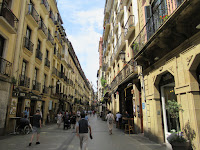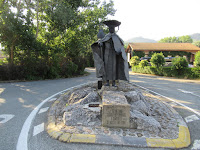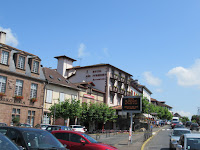I was once fascinated by so-called Esprit of French when I was a university student almost a half-century ago. I loved to read Balzac, Stendhal and Maupassant, wondering why I was more allured by an innocent prostitute dubbed as Boule de Suif. Although French was not a second foreign language for me to learn at university, I had attended to the Institut français du Japon – Kansai / Kyoto that stood in front of my university for around 2 years just for personal interest. I liked to hear my French teacher, a Parisienne, sometimes murmuring as “Mais, moi”, which sounded to me as an elegant expression of her personality and sticking to her own life-style. As one Japanese poet wrote about 100 years ago, I felt just like as “France is where I'd like to go, but France is so far away.....”.
And there’s one more French poem, which chanted as “Mon enfant, ma soeur, Songe à la douceur D’aller là-bas vivre ensemble!”. This was a kind of the sentiment akin to "Somewhere over the rainbow" and has been one of my favorite poems. Since those days 50 years have passed, now is the time to explore the land on foot.
 |
| The way to Santiago de Compostela |
 |
| Cirque de Gavarnie in the Pyrenees |
Train, car touring, and hiking journey
From July 15th to 29th, 2018, I had traveled for the first time in France, starting from Paris thru Bayonne, Lourdes, Carcassonne, and back again to Paris by train for 2 weeks. I have enjoyed the train journey, car driving in the Basque region along the way to Santiago de Compostela and hiking in the Pyrenees. Oh, yes a promenade along the river Seine was also impressive. It was really an exciting journey that I have long aspired, but it also made me think of people’s religious mind as well as the influence of Christianity on their culture.
- The Brown line shows the Train Route.
- The Blue ellipse the car driving route in the Basque
- Hiking in the Pyrenees based on Loudes
Train Journey
Soon after the train departed CDG2 TVG Station in Paris, the scenery changed to a rural landscape. Compared to Japan, the land was almost flat and green as far as I saw from a train window with sunflower fields dotted here and there under the summer blue sky. The train journey in France was pleasant and made me relaxed through the entire itinerary.

One thing that I felt odd was its pricing. The fare fluctuated wildly depending on when you buy a ticket and whether you have a special discount card or not. I capitalized on my seniority to buy a Carte Senior plus in advance which allowed me to buy every SNCF ticket with 25% discount. Usually you have to pay 60 euro for it as annual fee, but SNCF reduced its price from 60 to 29 euro in a certain limited time, which made sense for a temporally visitor like me from foreign countries.
No affordable automatic cars in France
I found it extreamly difficult to rent an automatic car in the country sides of France. In France unlike in Japan and USA, the automatic cars are very rare and are classified as expensive premium cars. As I have a physical difficulty with my right hand, my driver’s license is limited only to automatic cars. Most definitely you can't drop off a rent-a-car in a different place from a pick-up place. Finally, I decided to make a reservation using the carte SNCF’s 10% discount for a Mercedes Benz C-class with both pick-up and drop-off in Bayonne.
Chapter 1. Bayonne
On 16th July, I took the train at CDG2-TGV station going for Bordeaux, where I was joined by my old high school friend who had flew from Italy and transfered to another train for Bayonne. We arrived at the Bayonne station before 16 pm and after checking in at the hotel, we strolled around the street to cross the bridge “Pont Saint Esprit” over the Adour river into the old town of Bayonne, which consists of the two main districts, Grand Bayonne and Petit Bayonne.

Bayonne is the capital of the French Basque Country. It was founded as a Roman fortified town at the junction of the Nive and Adour Rivers and saw its 1st golden era during the Middle Ages thanks to maritime trade.
At the end of the bridge, another river Nive, a smaller one, flowed into the Adour. Grand Bayonne stands just on the opposite bank of the Nive river against Petite.

The Cathedral of Notre Dame de Ste Marie
Wherever you're in the town, you can see the two impressive spires of this cathedral of Notre Dame de Ste Marie. In the middle of the 12th century, a Romanesque cathedral was built in Bayonne, which was dedicated to Notre Dame and flanked by a cloister. Destroyed by several fires, it was reconstructed and renovated for the most part during the reign of the kings of England in the 13th century as a Gothic style of cathedral of today. In the 18th century, the choir was redecorated in the neo-Gothic style and the two spires on the western façade, finally built.

Ainhoa
On the next day, after we visited the Basque Museum, we rented a car at the AVIS car rental office close to the Bayonne train station. Our car was surprisingly a brand-new Toyota’s hybrid LEXUS car instead of a Bents C-class for which I made a reservation by online while in Japan. The only thing that confused us was the difficulty to handle its navigation system with full of capabilities. As even AVIS female staff gave up teaching us its complicated instructions, they provided us with an old outdated Gamin portable navi. Tomorrow we will start a long driving tour, so we needed some test driving beforehand to check the vehicle conditions including the Navi. So we headed for Aihoa.
Ainhoa is a small Basque village located 28 km south from Bayonne, lying quietly in the mountainous region close to the Spanish border. This village boasts the beautiful Basque style houses with bright red and green shutters, which were rebuilt in the 17th – 18th centuries after most of original houses had been destroyed during the Thirty Year’s War between 1618 and 1648. Ainhoa also has served as a place of shelter for pilgrims on the Way to Santiago de Compostela in Spain since 13th century.


Chapter 2. Pilgrim ways in the Basque
On 18th July, we departed from the AVIS car rental office close to the Bayonne train station at 9am, heading at first for San Sebastion in Spain and droved along the coastline of the Bay of Biscay. Our plan was to drive on the pligrim road to Santiago de Compostella, called as "Camino Frances", reversely from Puente la Reina in Spain to St-Jean-Pied-de-Port in France.
Saint-Jean-de-Luz
On the way, we dropped at Saint-Jean-de-Luz, an old beach resort town with colorful Basque houses. It was not overcrowded, a rather quite place. It is said that in 17th century, the golden age of the town, Saint-Jean-de-Luz made a transition from the important fishing port of France to a base for Basque corsairs. Many of the buildings date back to that era.
 |
| myself at St-Jean-de-Luz beach |
 |
| my friend of high school |
Basque culinar treatment at San Sebastian
San Sebastian, a Spanish name, is also called as Donostia in the Basque language. In 1982, they gave it fairly an official name of Donostia-San Sebastián. That’s why you have sometimes difficulty to locate San Sebastian on certain maps like Google.
After a short stay in Saint-Jean-de-Luz, we headed for San Sebastian in Spain, located just 20 km away from the boarder with France. We had made up our mind to taste the flavors of its famous pintxos for a lunch at this capital of the Basque cuisine, where Michelin star chefs are concentrated more than elsewhere in the world. After parking, we firstly visited the nearby tourist office for checking the culinary busy streets, walking through the “La Bretxa” market, which was named after the occupation by the Wellington’s English troops in 1813. A woman in the office said definitely that we should look for a restraunt on the "Fermin Calbeton" or "31 de Agosto" street in the old town.


 |
| at bar restraunt Gandarias |
 |
| Basque's pintxos |
Puent la Reina
We left San Sebastian soon after the pintxos lunch, heading directly for Puente la Reina, which is located 22 km south-west from Pamplona, the capital of Navarra, Spain that is also famous for its San Fermin festival depicted by Ernest Hemingway. Puente la Reina has been one of the key landmarks on the Pilgrim Way to Santiago de Compostela since the 12th century, as it was situated at the crossroads of the two key French routes crossing the Pyrenees. The main route from France enters Navarre, an autonomous community in Spain from St-Jean-Pied-de-Port and passes Pamplona, while the counterpart called as Aragonese way, passing through Somport to Aragon east to Navarre, joins the main route in Puente la Reina.
Puente la Reina, which means “Queen’s Bridge” was named after the Romanesque bridge crossing over the Arga river, which was constructed in the 11th century. From here Pilgrims crossed the river heading for Santiago.

The town was quite with few people seen on the old streets when we arrived at around 15:00 pm. It still preserved the medieval atmosphere of those golden era when people used to host warmly pilgrims traveling all the way from distant countries.


We found a cozy inn to stay for that night. I asked the maître d’hôtel about the guideposts on the Way to Santiago. “Where can I find the old guideposts on the route that were constructed during the medieval era?” I asked this because every guidepost I found on the way was a new one. She told me that there were no such old guideposts that had stood for centuries and that the route itself for example between Pamplona and Puente la Reina has changed. In the old days when water supply was crucial for pilgrims, they used to take the diffrent route closer to the river.

Note on the History of Santiago De Compostela
Let us take a glance at the history of the Pilgrim ways.
In 44 AD, Santiago or Saint James in English or St Jacque in French, who was one of Jesus Christ’s 12 apostles, was decapitated in Jerusalem. Legend said his body was carried in a boat to and buried in Spain, where he had preached. In 812, a hermit saw miraculous shining lights and found a cemetery with the tomb of the Apostle in Compostela. The King Alfonso 2 went to Compostela to visit the tomb, which was the beginning of the Christian pilgrimages to Santiago de Compostela.
It was in the 12th century that the numbers of pilgrims saw its peak and Santiago came to rank with Rome and Jerusalem as one of the great destinations of medieval pilgrimage.
Then how about in the modern era? In 1985, 1,245 pilgrims arrived in Santiago. And in the 2010 Holy Year, 272,703 pilgrims were qualified for the Compostela.
Pamplona to Ibañeta
On the next morning July 19, we drove back to Pamplona, the capital of Navarra, which is said to have been founded by the Roman general Pompey who fought here in 75–74 BC. So the name of Pamplona was derived from him. Parking at the center of the city, we strolled around the Plaza del Castillo for a while. Then we headed toward Puerto de Ibañeta, mountain pass in the Pyrenees at the height of 1,057m above the sea level, along the way to Santiago. Before reaching Ibañeta, we drove through the old villages of Burguete and Roncesvalles. It would be fantastic to walk across the Pyrenees staying at a inn in these villages if I had more time, I imagined.

The pass is very close to the border between France and Spain. It was here that on 15 August 778, the Basques defeated a Frankish army of Charlemagne which was returning to France after fighting in Zaragoza against the Moors. This was called as the Battle of Roncevaux Pass and Roland, count of the Breton March, who led the rearguard for the troops died here. Thus the epic poem “Chanson de Roland”, was created and sung throughout Europe. I had a vague memory to read the Japanese translated version of this story for children when I was a boy who loved to read the stories about historical events and heros. There was a gravestone erected on the site where Roland was believed to be killed.


We could have a nice view of the Pyrenees and saw some signposts for pilgrims. There were the two men working on re-construction of a church. They said that there had been standing an old church and a clinic here since the Roman era.

There have been the two typical routes to Santiago crossing over the Pyrenees, the route thru Ibañeta pass and the other one thru Somport pass. Until the end of 12th century, pilgrims rather choosed the the Somport pass because they were afraid of a bunch of Basque burglars around Ibañeta. But after they were suppressed, the route over Ibañeta pass have become more dominant due to its lower altitude compared to Somport at the elevation of 1632m.
This anecdote reminds me of the dificulties and challenges that pilgrims were facing in those days as they took one or two months walking to reach to Santiago only wishing to save their souls.
St-Jean-Pied-de-Port
From Ibañeta we crossed the border into St-Jean-Pied-de-Port, where the gate of St-Jacques, the historic entrance in France for pilgrims on the way to Santiago before crossing the Pyrenees was located. The town was busy with tourists, hikers, and protesters who opposed the abolition of the town's railway station, far more lively than its counterpart of Puente la Reina in Spain.

On the streets, we saw many modern pilgrims or hikers walking around with a rucksack on their back. The town is also popular among French tourists as one of the great tourist destinations.
Historically, the town was constructed in the latter part of 12th century by the King of Navarre, and became an important strategic point for a fortress, a commercial center, and the resting place for pilgrims from the north before crossing the Pyrenees on their way to Santiago de Compostela.


The gate of St-Jacques
This gate was was added to the UNESCO World Heritage Sites as part of the sites on the ways to Santiago in 1998. A lot of Pilgrims have headed toward Ibañeta, the Roncevaux pass, around 25 km away from the town passing through this gate since the 12th century. This asent requires them almost 7 hours trekking.


The Citadelle
Beside the gate, there is a gentle slope which leads to the main entrance to the Citadelle, which dominates the town and the surrounding area. Since the Roman era there had been constructed fortifications here, but the present one was built between 1625 to 1627 and improved again during the 1640s in the era of Louis XIV (1638 - 1715), known as the Sun King, a monarch of the House of Bourbon who reigned as King of France and Navarre from 1643 until his death in 1715.


The church of Notre Dame-du-Bout-du-Pont
This Gothic building standing along the river Nive was originally built by Sancho, the strong of Navarre in commemoration of the 1212 Battle of Las Navas de Tolosa against the Moorish dominance of Spain.

After strolling around this colorful town of St-Jean-Pied-de-Port with rich history, we drove back to Bayone to catch up the train for Lourdes, a base town for us to take excursions to the Pyrenees.
Additionally, about the Way of St. Jacque
There have been two typical routes in France for the Way of St. James, with Paris and Le Puy near Lyon as a starting point respectively. If you take Paris(Le Puy) route, you are going to walk down around 800 km(736 km) to the Cathedral of St. James in the city of Santiago de Compostela, Spain. In both cases, ancient pilgrims struggled to make their way to Santiago for at least more than one month just in seeking to save their souls, guided only by vague sign posts on the routes, suffering sometimes from severe weather, illness or taking the risk of being attacked by robbers on the way. I wondered what kind of people decided to travel on foot as a pilgrim in those medieval period, young or senior, rich or poor, merchant, farmer or aristocrat, man or woman and how they were supported by their societies and establishments. I realized from this small tour how the Way of St. James represented the deep belief in the God among people in the medieval period and that there was some kind of social system in that era to support them financially and physically, thus promoting the freedom of movements in Europe.
(To be continued; the next is "the Pyrenees" )



























This comment has been removed by a blog administrator.
ReplyDelete